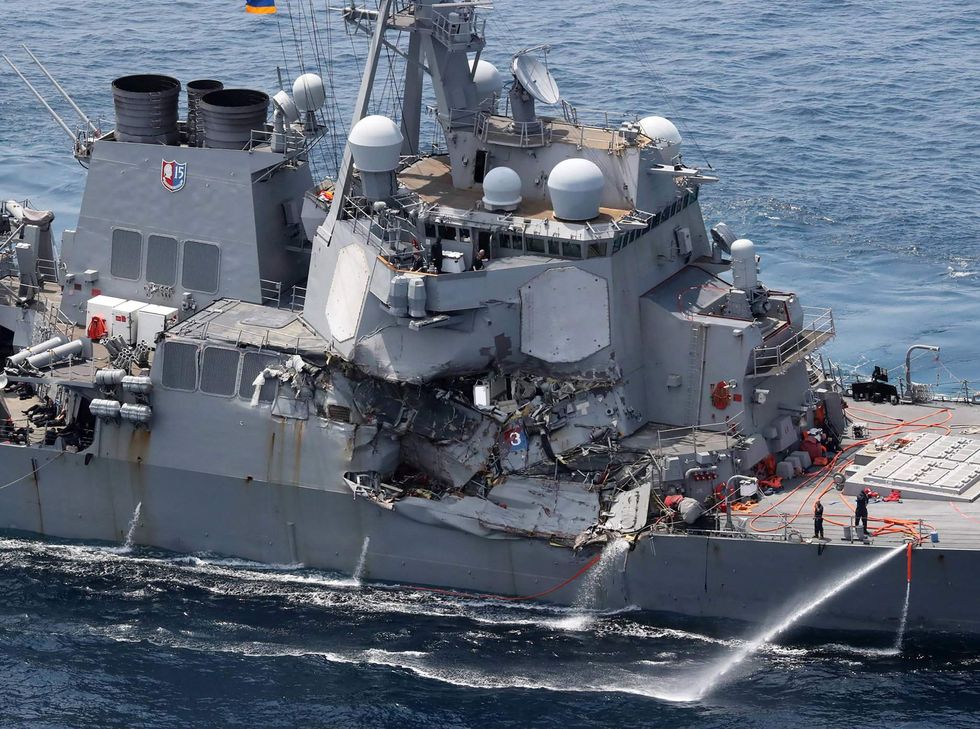
A new technology capable of fooling a GPS system into believing it's somewhere it's not is being considered as the prime culprit in a number of cases involving misguided ships, and collisions with U.S .warships. (Getty Images)

New cyberwarfare technology may be emerging that allows a malicious operator to "spoof" a GPS system, sending the craft relying on off course without the crew's knowledge. Experts wonder if it was used in the South China Sea with the recent collision of the USS John S McCain and an oil tanker.
According to New Scientist, on July 22, the U.S. Maritime Administration filed what seemed like an innocuous report from a ship's captain off the Russian port of Novorossiysk in Russia's Black Sea. According to the captain, his GPS had placed his ship at the Gelendzhik Airport 32 kilometers inland.
The captain checked his GPS for errors, then contacted other captains to see if they had the same problems. The captain discovered that 20 vessels had been affected the same way. All GPS systems show them sitting at the same airport.
The Maritime Administration issued warnings of the GPS interference despite not being able to confirm the story.
The New Scientist reported that interference with satellite signals being jammed was always the largest problem for GPS. GPS signals can be muddled or masked by white noise. Signal interference is easily recognizable, and alarms are supposed to sound to alert the crew when this happens.
However, a spoofed GPS signal is much harder to detect. A false signal from a ground station can confuse the satellite receivers, giving the ship's GPS the impression it's somewhere it's not.
“Jamming just causes the receiver to die, spoofing causes the receiver to lie,” David Last, former president of the UK’s Royal Institute of Navigation told New Scientist.
Autonomy and robotics expert Todd Humphreys at the University of Texas in Austin had conducted attack experiments using the same technology in the past. Humphreys said the signs of an attack during the Black Sea incident were the same as the results he had gotten during his experiments.
“The receiver’s behavior in the Black Sea incident was much like during the controlled attacks my team conducted,” Humphreys said.
Humphreys suggested that this might represent Russia experimenting with a new type of cyberwarfare technology. The New Scientist reported that the technology had first been seen in Moscow, centered near the Kremlin.
According to Humphreys, the satellite receivers on people's phones in Moscow would malfunction. Gamers playing the Pokemon GO game on their phones discovered the extent of the alleged GPS spoofing attacks emanating from the Kremlin.
Humphreys told the New Scientist that this technology isn't very hard to build. In 2008, it required considerable technological expertise available only to governments. Humphreys said anyone with enough technical knowledge could now piece together a GPS spoofing device from commercial hardware and software downloaded from the internet.
Humphreys said this could help any tech-savvy person cause chaos with the GPS spoofing technology due to its easy construction.
“It affects safety-of-life operations over a large area,” he said. “In congested waters with poor weather, such as the English Channel, it would likely cause great confusion, and probably collisions.”
Both the U.S. Navy and intelligence experts began to consider the idea of a cyberattack as the potential cause of an oil tanker's collision with the USS John S McCain in the South China Sea on Monday. In conjunction with the collision of the USS Fitzgerald and a crate ship that happened just two months prior in the sea of Japan, it seem like less of a coincidence.
There has been no confirmation that the John S McCain and Fitzgerald events were cyberattacks. However, experts have strongly begun to consider the idea that the technology seen in Russia is now being used in China.
Trade routes in the South China Sea are highly lucrative and highly contested. Beijing believes the trade routes — which see some $5 trillion a year through its waters — belong to China. However, Brunei, Malaysia, the Philippines, Taiwan, and Vietnam disagree. While all the countries use these trade routes to ferry goods, they rely on the U.S. to keep the trade routes open.
The John S McCain was a warship used for the Freedom of Navigation Operations in the South China Sea. The purpose of the operations is to challenge China's claim over the South China Sea trade routes. The warship was on its way back from navigating just 12 miles off China's Spratly Islands in the most unambiguous challenge to China's claim of ownership of the trade waters yet.
It's curious to some that a crew with a heightened alert status, fresh off a mission that defied a major national power, would not notice, or easily avoid a 600-foot Liberian oil tanker.